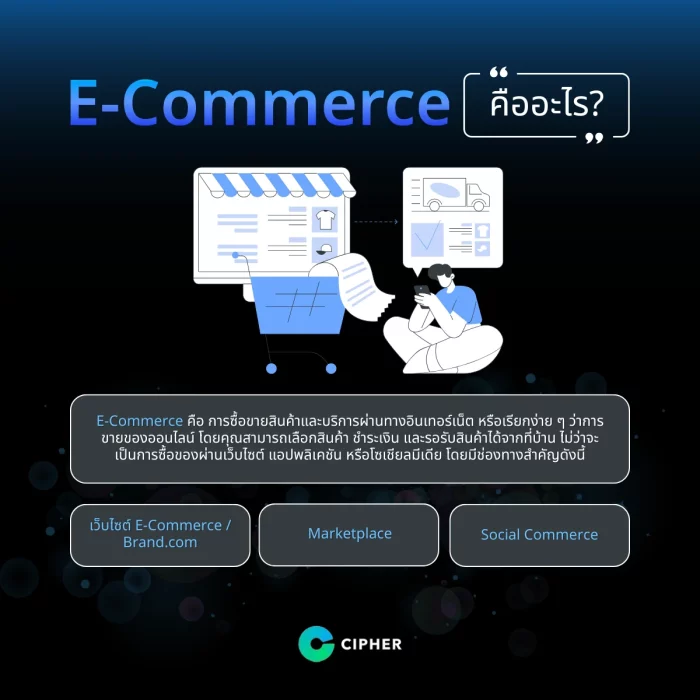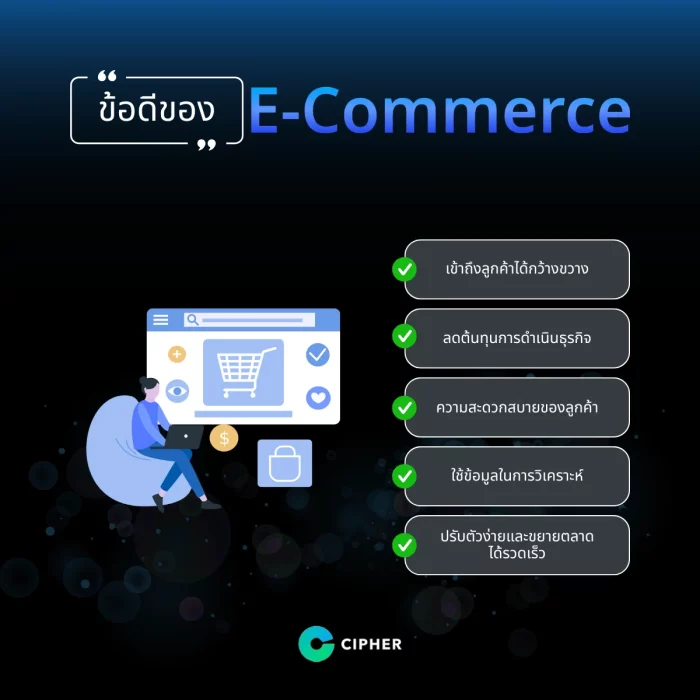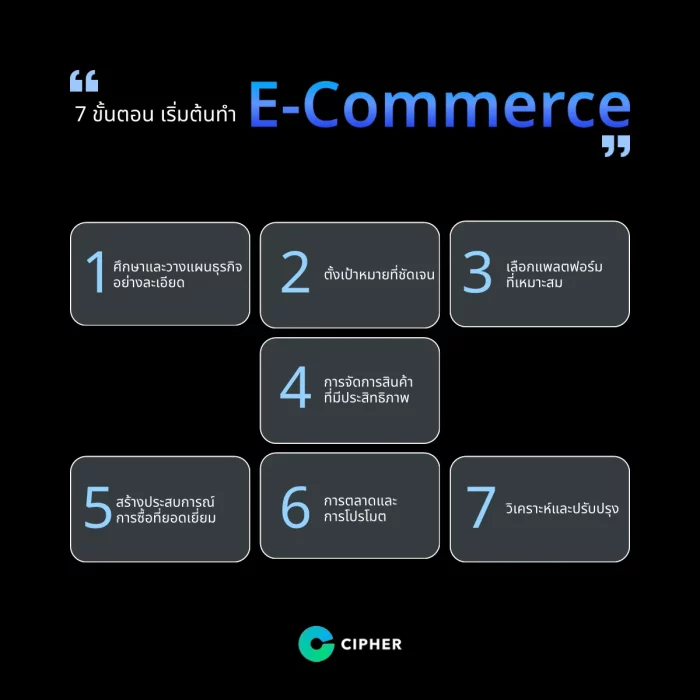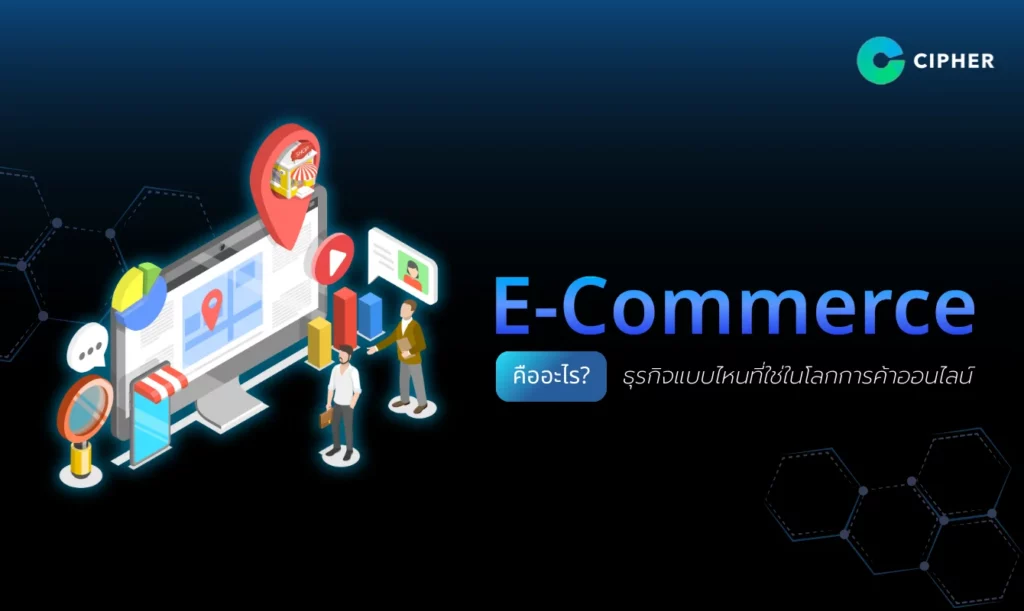Table of Contents
What is E-Commerce? What types of businesses are suitable for? Deep dive into online trading in the digital age
What is E-Commerce? has become an important question for business owners who want to adapt and grow in the online world. “E-Commerce” or “electronic trading” is the buying and selling of goods and services through online channels, covering everything from website design, trading system management, to digital marketing.
For those who want to start an e-commerce business, choosing a platform and web design is a key step, such as choosing E-Commerce Magento and Woo Commerce or Shopify, which is suitable for businesses that need flexibility and features. In addition, e-Commerce Template Design and Development. It also makes your website more professional and easy to use and offers more marketing opportunities with social media management services to help create brand awareness and attract target customers.
In this article, we will introduce you to E-Commerce in more depth and advise you which business is ideal for entering the online world of commerce and how to get started best for you!
What is E-Commerce?

E-Commerce is an online trading of products and services, or simply online sales, where you can choose, pay and wait at home, whether it’s through websites, applications or social media such as Shopee. Lazada or Facebook Marketplace, all processes from product selection, ordering and payment are done online, making it much more convenient and faster.
E-Commerce or e-commerce offers a wide range of products, such as direct store-to-consumer (B2C), inter-consumer (C2C), or inter-business (B2B). The advantage of e-commerce is that it allows you to trade products anytime, anywhere without the need for a storefront, saving time and cost. At the same time, and helping businesses reach even wider customers.
Types of E-Commerce to Know
Understanding the type of E-Commerce is an important starting point for entering online businesses. Each type has a different working style and target group as follows:
follow a business model
- B2C (Business to Consumer): Selling business products or services directly to consumers, such as buying clothes through Lazada or supplements through the brand’s website.
- B2B (Business to Business): Business-to-business transactions such as manufacturers selling products to distributors or providing corporate software. The application of E-Commerce in B2B marketing strategies is a popular strategy.
- C2C (Consumer to Consumer): Trading between consumers such as selling secondhand goods via Facebook Marketplace or eBay.
- Other categories (B2G and C2B): such as B2G, government sales, and C2B, consumers offer businesses such as freelance logo design.
By Product & Service Type
- Physical Goods: General goods such as clothing, books and electrical appliances that must be delivered to customers.
- Digital Goods: Goods delivered online such as music, games, software or online courses.
- Online Services: Internet-based services such as hotel reservations, Netflix subscriptions, or online tutorials through multiple platforms.
Sales channels on E-Commerce
Choosing the right E-Commerce sales channel is critical to making it easier for businesses to reach their customers, with the following key channels:
E-Commerce website / Brand. com
Sales through E-Commerce website or Brand. com is to create their own website for direct sales and services. These websites are suitable for businesses that want to create their own brands. Popular e-commerce web-based platforms such as Shopify and Magento. E-Commerce’s highlights are:
- All-in-control: Design and features can be customized to suit the brand.
- Build a trustworthy image: strengthen professionalism and increase trust in
- No platform fee: Reduce costs because you don’t have to pay a commission to Marketplace.
- Full customer data collection: Web-based sales enable businesses to collect customer data directly to analyze and adjust marketing strategies.
- Full customer data collection: Web-based sales enable businesses to collect customer data directly to analyze and adjust marketing strategies.
Marketplace
Marketplace is a large e-commerce site. It is a platform that combines sellers and buyers in one place. Marketplace services will have a percentage or share deduction from sales such as Shopee, Lazada, or Amazon, with the following features:
- It’s easy to use. Vendors who just sign up for it can start selling immediately.
- have a large customer base in oneself
- Comprehensive sales support systems such as payment and delivery systems
- There are promotional campaigns to attract customers such as promotions and discounts.
Social Commerce
Social commerce is the sale of social media products such as Facebook Marketplace or LINE Shopping. Social media will focus on promoting, communicating and connecting with customers. The highlights are:
- communicate with and interact directly with customers
- Make it interesting with content such as live broadcasts or post reviews.
- use advertising to reach a clear target audience
- It is suitable for products that want to build trust with various strategies and techniques for creating content.
Advantages and Considerations for Making E-Commerce
E-Commerce has the advantage of helping businesses grow and reach more customers, but all approaches have advantages and considerations. If implemented properly, it will help businesses succeed.
Advantages of doing E-Commerce

- Access to a wide range of customers: Sales can be made anywhere, anytime, anywhere, not limited to the area, making it easier to reach customers around the world.
- Reduce business costs: e-commerce is about selling products or services online, eliminating the need for a real storefront, reducing space rentals and other expenses.
- Customer convenience: Customers can choose to purchase, compare prices and pay anywhere and anytime, increasing their sales opportunities.
- Use the data to analyze: Customer behavior data can be stored to market to the target, such as offering promotions that meet the customer’s needs.
- Easy to adjust and quickly expand the market: New products can be added or entered into new markets without much investment.
Consideration for doing E-Commerce
- Customers do not see the product directly: All products or services need to be included in the photo or details because customers cannot touch the product directly.
- Restricted Services: Due to the inability to offer products or services directly, and some platforms have different limitations, techniques are needed to persuade customers.
- Competition: e-commerce is a platform in the online market with a large number of vendors, making it a must-have feature to attract customers.
- Customer confidence: Reliability must be established, such as a secure payment system and good after-sales service.
- Logistics Management: The product must be planned quickly and efficiently to ensure satisfaction.
E-Commerce trends in 2025
In 2025, the trend of E-Commerce has evolved and changed in many ways, influenced by technology, changes in consumer behaviour and global economic factors. Key trends expected include:
- AI and Chatbots: AI will play a greater role as AI will enable E-Commerce platforms to more accurately understand customer behavior, enabling better introduction of products, services and promotions tailored to each customer’s needs.
- Social commerce and live commerce continue to grow: Facebook will develop features that allow users to shop directly through Live Commerce apps. In Asia, especially China and Thailand, where consumers are familiar with live TV to shop.
- Digital payments and financial systems: Buy Now or Pay Later will become more popular, allowing customers to trade more conveniently and make faster purchasing decisions.
- Augmented Reality (AR) and Virtual Reality (VR): AR and VR technologies will be used to enhance the shopping experience, such as experimenting with virtual goods or simulating home furnishing with furniture.
E-Commerce in 2025 will be more competitive, with brands that adapt and respond well to these trends will have sustainable growth opportunities in the future.
How to Start E-Commerce To be successful.
Getting started with e-commerce is a challenge for all types of businesses, and to succeed, requires systematic planning, market understanding and adaptation to customer needs. Here are some key steps.

1. study and plan one's business thoroughly
- Select Target Market: Understand who your target customers are. What’s the buying behavior? And what kind of product do you like?
- Competitor analysis: Learn what competitors in your marketplace do. What’s good, and… What are the weaknesses to make a difference?
- Select a product category: Choose a product with high growth potential or a product with your expertise.
2. set a clear goal
- Set goals such as monthly sales, new customer access, or brand awareness.
- Plan the appropriate budget for starting a business such as advertising costs, website development, and logistics.
3. Select the appropriate platform.
- Online sales platforms: such as Lazada, Shopee and Amazon, if you want to use a market that already has customers.
- Create your own website: Use powerful web-creating tools like Shopify, WooCommerce or Magento.
- Social Media Commerce: Use Facebook or Instagram to start selling or opening a store immediately without too much investment.
efficient handling of goods
- Product Source: Choose a trusted vendor with competitive costs.
- Inventory management: Start with small inventory management to avoid inventory losses.
5. create a great buying experience
- Easy-to-use website: Allow customers to find products and make payments conveniently.
- Quick Delivery: Choose a quality transport partner and have a parcel tracking system.
- Customer Service: There is a convenient way for customers to contact such as Live Chat or Chatbot.
6. Marketing and Promotion
- SEO and Content Marketing: Create content that helps attract customers through Google searches.
- Online advertising: Using social media platform tools like using Facebook Ads or Google Ads to increase visibility.
- Social Media: Post product content or create promotional campaigns regularly.
- Influencer Marketing: Collaborate with Influencers in your target audience.
7. analyze and improve
- Use information for decision making: track performance such as click rate (CTR), conversion rate, and sales.
- Adjust strategies according to market demand: Respond to trends or customer opinions.
- Learn from competitors and markets: Study the weaknesses or competitive points of competitors and improve the development of their own products and services.
- Increase sales channels: Study the markets of countries to accommodate future business growth or expansion into overseas markets.
Summary
E-Commerce is an online trading platform that enables businesses of all sizes to grow in the digital age. Whether you are a small business or a large enterprise, choosing the right platform, such as Magento, Woo Commerce or Shopify, along with its easy-to-use website design and professional social media management, will help increase its potential and expand its customer base. Going to the world of e-commerce is not just an opportunity, but an important business in the digital age!
Frequently Asked Questions About E-Commerce Business
E-commerce is indispensable for businesses that want to sell products or services online. For brands or businesses that are about to enter the world of e-commerce, there may be questions that we have gathered for you about e-commerce and answers.
E-Commerce is in business. Anything?
E-Commerce covers a wide range of businesses, which can be classified according to product and service characteristics and business models as follows:
- O2O Marketing: Businesses that connect online and offline marketing, such as promoting products on the website or social media and attracting customers to buy products or use services at real stores. A clear example is promotion campaigns in front-of-door applications such as Starbucks Rewards or GrabMart. That supports online ordering and picking up at the store.
- D2C (Direct to Consumer): Businesses where manufacturers sell products directly to customers without intermediaries, such as dealers or shops, reduce costs and build close relationships with customers. For example, cosmetics brands selling products via their own website, Glossier or Warby Parker, selling online glasses and home tryouts.
- Crypto Currency/Virtual World / Metaverse: E-Commerce businesses associated with digital and virtual currencies, such as trading products or services through Crypto Currency, creating and selling NFT products or selling virtual goods on Metaverse platforms such as Decentraland or Roblox, where users can purchase digital goods to decorate their characters or virtual worlds.
How does E-Commerce work? ?
E-Commerce or e-commerce is the online trading of goods and services using digital platforms and technologies in commercial transactions. E-Commerce can be divided into the following main steps:
- Step 1: Vendors offer products and services online, including Web sites, applications and social media.
- Step 2: Customers can choose to view the items they are interested in and add them to the product basket.
- Step 3: The customer reviews the basket inventory and performs payment through the designated system.
- Step 4: The system sends order information to the vendor dashboard.
- Step 5: Vendors check and confirm orders in the system
- Step 6: The system forwards the order information to the warehouse department for delivery.
- Step 7: The system alerts the delivery status and tracking information to the customer.
- Step 8: The shipper carries the shipment to the destination as specified by the customer.
The format of E-Commerce is available Anything?
E-commerce is a business model that can reach a wide range of customers and reduces business expenses. Many executives prefer full-scale e-commerce. Businesses must consist of at least two parties: buyers and sellers. The types of e-commerce businesses can be divided as follows:
- B2C (Business to Consumer): Direct trade between businesses and consumers is the most common form and is used today, such as online stores.
- B2B (Business to Business): Trading between businesses is often about purchasing raw materials, equipment or services for business operations. E-Commerce marketing strategies for B2B businesses are not to be overlooked.
- C2C (Consumer to Consumer): Trading between consumers, e.g., online market platforms.
- C2B (Consumer to Business): Consumers have the power to negotiate pricing and conditions such as auction sites.
- G2C (Government to Consumer): Government-to-people services such as online driver’s license system.
- G2B (Government to Business): Government services for businesses such as licensing systems.
- B2G (Business to Government): Businesses that provide services to government agencies such as public works auctions.
- C2G (Consumer to Government): People are engaged in government transactions such as online tax payments.





